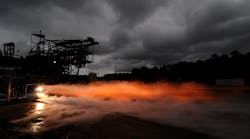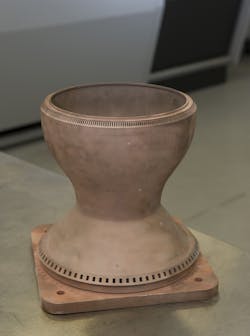Developments in copper-alloy materials and 3D-printing techniques for rocket parts are expected to expedite the process of human occupancy on Mars, as well as improve metal-powder additive manufacturing on Earth. A recent demonstration at the Marshall Space Flight Center in Huntsville, Ala., proved the capabilities of an additive-manufacturing demonstrator engine (AMDE) for applications including in-space propulsion systems and rocket-engine upper stages.
Watch the demonstration in the video below:Constructed out of more than 75% 3D-printed parts, this AMDE holds the most 3D-printed parts of any of NASA’s engines, and achieves 20,000 lb. of thrust at 90,000 revolutions per minute. The assembly uses cryogenic (very cold) oxygen and liquid hydrogen as fuel, withstanding temperature gradients from cryogenic to very, very hot. Its 3D-printed turbopump pumps 1,200 gallons of liquid hydrogen per minute. The assembly uses materials that have been developed over the years by the Glen Research Center in Cleveland.
Copper Parts Created via Selective Laser Melting
The lining for the first 3D-printed combustion chamber was constructed in April using GRCo-84, a copper alloy developed by Glen researchers. The inner lining is robust against rapid transitions from cryogenic fuel temperatures to temperatures as high as 5000° F. It incorporates 200 intricately thin cooling channels, where cooling fluid is circulated to protect the piece from high temperatures inside the chamber. 3D printing proved practical for such an intricate design in contrast to traditional manufacturing processes, but developing a copper alloy that could be melted for 3D printing and withstand high and low temperatures in a finished assembly was a challenge.
The GRCo-84 alloy is 3D printed using selective laser melting, where the alloy powder is layered onto the assembly and melted into place. With 8,255 layers in total, it took 10 days and 18 hours to construct the lining. It was then sent to another NASA location so that a nickel-alloy structural jacket could be implemented. Now, similar technology and materials are proving useful in NASA tests of 3D-printed engines.
NASA offers its Glenn database of mechanical and material properties for 3D printing engines to American manufacturers in NASA’s Materials and Processing Information System (MAPTIS), managed by Marshall.

